文件
什么是文件

文件流

常用的文件操作
创建文件对象相关构造器和方法
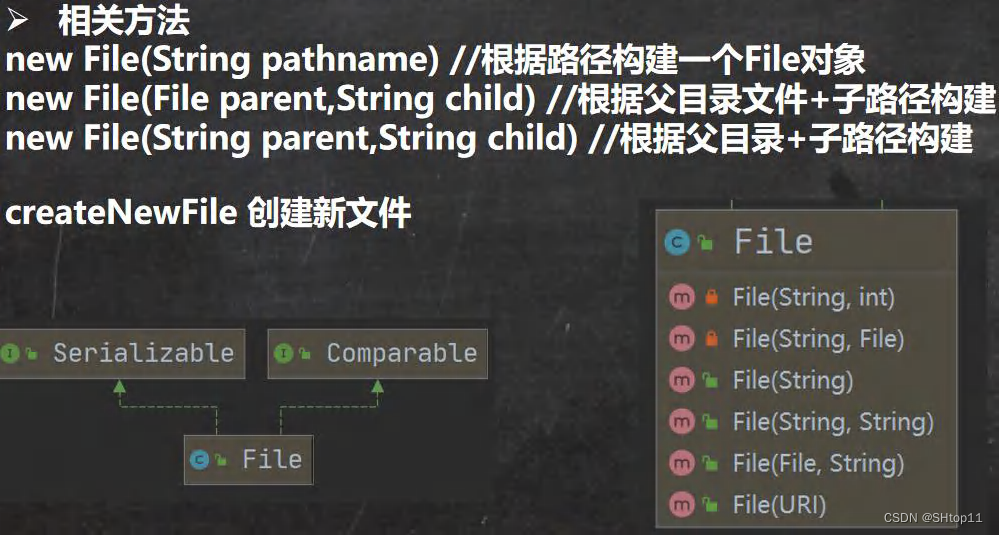

public class FileCreate {
public static void main(String[] args) {
}
//方式 1 new File(String pathname)//根据路径构建一个File对象
@Test
public void create01() {
String filePath = "e:\\news1.txt";
File file = new File(filePath);
try {
file.createNewFile();
System.out.println("文件1创建成功");
} catch (IOException e) {
e.printStackTrace();
}
}
//方式 2 new File(File parent,String child) //根据父目录文件+子路径构建
//d:\\news2.txt
@Test
public void create02() {
File parentFile = new File("e:\\");
String fileName = "news2.txt";
//这里的 file 对象,在 java 程序中,只是一个对象
//只有执行了 createNewFile 方法,才会真正的,在磁盘创建该文件
File file = new File(parentFile, fileName);
try {
file.createNewFile();
System.out.println("文件2创建成功");
} catch (IOException e) {
e.printStackTrace();
}
}
//方式 3 new File(String parent,String child) //根据父目录+子路径构建
@Test
public void create03() {
String parentPath = "e:\\";
String filePath = "news3.txt";
File file = new File(parentPath,filePath);
try {
file.createNewFile();
System.out.println("文件3创建成功");
} catch (IOException e) {
e.printStackTrace();
}
}
@Test
public void create04() {
String parentPath = "e:/";
String filePath = "news4.txt";
File file = new File(parentPath,filePath);
try {
file.createNewFile();
System.out.println("文件4创建成功");
} catch (IOException e) {
e.printStackTrace();
}
}
//下面四个都是抽象类
//InputStream
//OutputStream
//Reader //字符输入流
//Writer //字符输出流
}
获取文件的相关信息

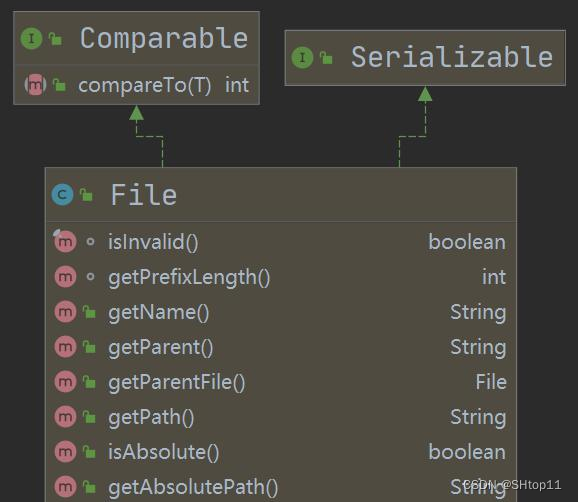
应用案例演示

public class FileInformation {
public static void main(String[] args) {
}
@Test
//获取文件的信息
public void info() {
//先创建文件对象
File file = new File("d:\\news1.txt");
//调用相应的方法,得到对应信息
System.out.println("文件名字 = " + file.getName());//news1.txt
//getName、getAbsolutePath、getParent、length、exists、isFile、isDirectory
System.out.println("文件绝对路径 = " + file.getAbsolutePath());//d:\news1.txt
System.out.println("文件父级目录 = " + file.getParent());//d:\
//news1 内容:hello啦啦啦
System.out.println("文件大小 = " + file.length());//14
System.out.println("文件是否存在 = " + file.exists());//true
System.out.println("是不是一个文件 = " + file.isFile());//true
System.out.println("是不是一个目录 = " + file.isDirectory()); //false
}
}
目录的操作和文件删除

应用案例演示

public class Directory_ {
public static void main(String[] args) {
}
//判断 d:\\news1.txt 是否存在,如果存在就删除
@Test
public void m1() {
String filePath = "d:\\news2.txt";
File file = new File(filePath);
if (file.exists()) {
if (file.delete()){
System.out.println(filePath + " 删除成功");
}else {
System.out.println(filePath + " 删除失败");
}
}else {
System.out.println("该文件不存在...");
}
}
//判断 D:\\demo02 是否存在,存在就删除,否则提示不存在
//这里我们需要体会到,在java编程中,目录也被当做文件
@Test
public void m2() {
String filePath = "D:\\demo02";
File file = new File(filePath);
if (file.exists()) {
if (file.delete()){
System.out.println(filePath + " 删除成功");
}else {
System.out.println(filePath + " 删除失败");
}
}else {
System.out.println("该目录不存在...");
}
}
//file.mkdirs() 创建多级目录
//判断 D:\\demo\\a\\b\\c 目录是否存在,如果存在就提示已经存在,否则就创建
@Test
public void m3() {
String directoryPath = "D:\\demo\\a\\b\\c";
File file = new File(directoryPath);
if (file.exists()) {
System.out.println(directoryPath + " 存在...");
}else {
if (file.mkdirs()) { //创建多级目录
System.out.println(directoryPath + " 创建成功...");
}else {
System.out.println(directoryPath + " 创建失败...");
}
}
}
//file.mkdir() 创建一级目录
//判断 D:\\demo 目录是否存在,如果存在就提示已经存在,否则就创建
@Test
public void m03() {
String directoryPath = "D:\\demo03";
File file = new File(directoryPath);
if (file.exists()) {
System.out.println(directoryPath + " 存在...");
}else {
if (file.mkdirs()) { //创建一级目录
System.out.println(directoryPath + " 创建成功...");
}else {
System.out.println(directoryPath + " 创建失败...");
}
}
}
}
根据目录显示文件
编写一个程序,在输入文件目录后显示所有文件(包括子目录中的文件)
public class ListFilesRecursive {
public static void main(String[] args) {
Scanner scanner = new Scanner(System.in);
// 提示用户输入要列出文件的目录路径
System.out.print("请输入要列出文件的目录路径: ");
String directoryPath = scanner.nextLine();
scanner.close();
File directory = new File(directoryPath);
// 检查目录是否存在
if (!directory.exists()) {
System.out.println("目录不存在: " + directoryPath);
return;// 如果目录不存在,直接退出程序
}
// 调用递归方法列出所有文件
listFiles(directory);
}
public static void listFiles(File directory) {
// 获取目录下所有文件和子目录
File[] files = directory.listFiles();
if (files != null) {
for (File file : files) {
if (file.isDirectory()) {
// 递归调用自身,处理子目录
listFiles(file);
} else {
// 输出文件路径
System.out.println("文件: " + file.getAbsolutePath());
}
}
}
}
}
IO 流原理及流的分类
Java IO 流原理


流的分类
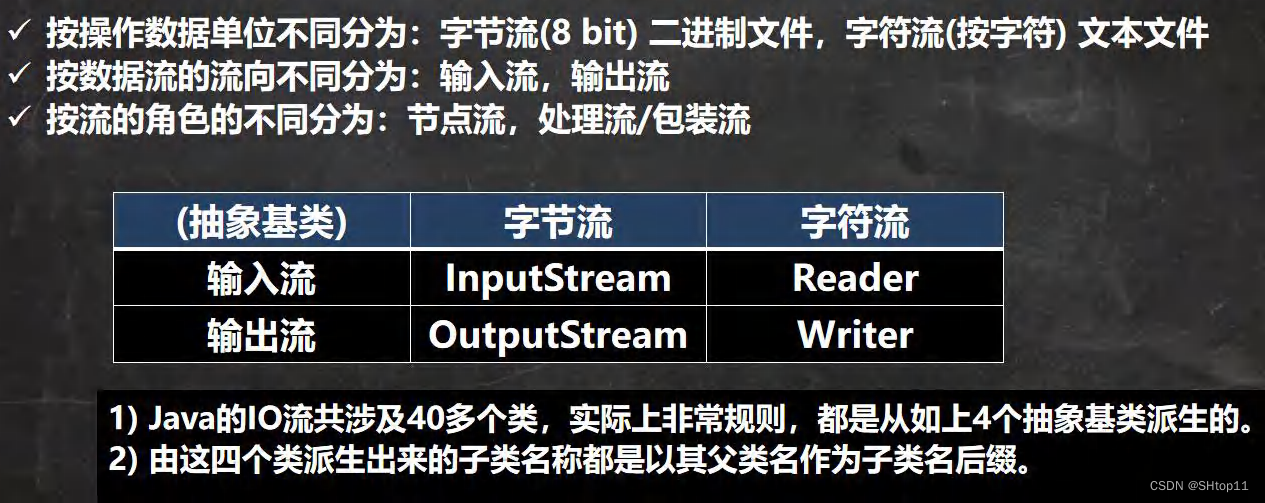
IO 流体系图-常用的类
IO 流体系图
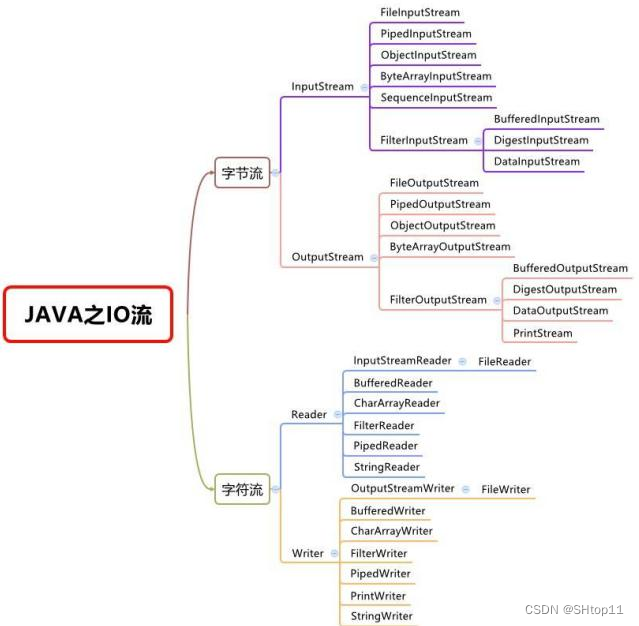
文件 VS 流
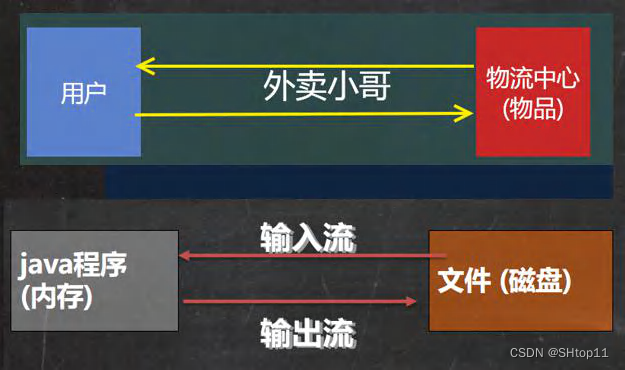
FileInputStream 介绍
FileInputStream 应用实例
/**
* 演示 FileInputStream 的使用(字节输入流 文件--> 程序)
*/
public class FileInputStream_ {
public static void main(String[] args) {
}
/**
* 演示读取文件...
* 单个字节的读取,效率比较低
*/
@Test
public void readFile01() {
String filePath = "d:\\hello.txt";
int readData = 0;
FileInputStream fileInputStream = null;//定义在外边,扩大作用域
try {
//创建 FileInputStream 对象,用于读取文件
fileInputStream = new FileInputStream(filePath);
//从该输入流读取一个字节的数据。 如果没有输入可用,此方法将阻止。
//如果返回-1 , 表示读取完毕
while ((readData = fileInputStream.read()) != -1) {
System.out.print((char) readData);//转成 char 显示
}
} catch (IOException e) {
e.printStackTrace();
}finally {
//关闭文件流,释放资源
try {
fileInputStream.close();
} catch (IOException e) {
e.printStackTrace();
}
}
}
/**
* -> 使用 read(byte[] b) 读取文件,提高效率
*/
@Test
public void readFile02() {
String filePath = "d:\\hello.txt";
int readLen = 0;
//定义一个字节数组
byte[] buf = new byte[8]; //一次读取 8 个字节
FileInputStream fileInputStream = null;//定义在外边,扩大作用域
try {
//创建 FileInputStream 对象,用于读取文件
fileInputStream = new FileInputStream(filePath);
//从该输入流读取最多 b.length 字节的数据到字节数组。 此方法将阻塞,直到某些输入可用
//如果返回-1 , 表示读取完毕
//如果读取正常, 返回实际读取的字节数
while ((readLen = fileInputStream.read(buf)) != -1) {
System.out.print(new String(buf,0,readLen));//转成 char 显示
}
} catch (IOException e) {
e.printStackTrace();
}finally {
//关闭文件流,释放资源
try {
fileInputStream.close();
} catch (IOException e) {
e.printStackTrace();
}
}
}
}
FileOutputStream 介绍

FileOutputStream 应用实例
要求: 请使用 FileOutputStream 在 a.txt 文件,中写入 “hello,world”, 如果文件不存在,会创建文件(注意:前提是目录已经存在)
public class FileOutputStream01 {
public static void main(String[] args) {
}
/**
* 演示使用 FileOutputStream 将数据写到文件中,
* 如果该文件不存在,则创建该文件
*/
@Test
public void writeFile() {
//创建 FileOutputStream 对象
String filePath = "d:\\a.txt";
FileOutputStream fileOutputStream = null;
try {
//得到 FileOutputStream 对象
//1. new FileOutputStream(filePath) 创建方式,当写入内容是,会覆盖原来的内容
//2. new FileOutputStream(filePath, true) 创建方式,当写入内容是,是追加到文件后面
fileOutputStream = new FileOutputStream(filePath);
//写入一个字节
//fileOutputStream.write('H');
//写入字符串
String str = "hello,world!";
//str.getBytes() 可以把 字符串 -> 字节数组
//fileOutputStream.write(str.getBytes());
/*
write(byte[] b, int off, int len) 将 len 字节从位于偏移量 off 的指定字节数组写入此文件输出流
*/
fileOutputStream.write(str.getBytes(), 0, 3);
} catch (IOException e) {
e.printStackTrace();
} finally {
try {
fileOutputStream.close();
} catch (IOException e) {
e.printStackTrace();
}
}
}
}
FileOutputStream 应用实例 2
要求: 编程完成图片/音乐 的拷贝
public class FileCopy {
public static void main(String[] args) {
//完成 文件拷贝,将 d:\\22.jpg 拷贝 d:\\220.jpg
//思路分析
//1. 创建文件的输入流 , 将文件读入到程序
//2. 创建文件的输出流, 将读取到的文件数据,写入到指定的文件
String filePath = "d:\\22.jpg";
String destPath = "d:\\220.jpg";
FileInputStream fileInputStream = null;
FileOutputStream fileOutputStream = null;
try {
fileInputStream = new FileInputStream(filePath);
fileOutputStream = new FileOutputStream(destPath);
//定义一个字节数组,提高读取效果
byte[] buf = new byte[1024];
int readLen = 0;
while ((readLen = fileInputStream.read(buf)) != -1) {
//读取到后,就写入到文件 通过 fileOutputStream
//即,是一边读,一边写
fileOutputStream.write(buf,0,readLen);//一定要使用这个方法
}
System.out.println("拷贝ok~");
} catch (IOException e) {
e.printStackTrace();
} finally {
try {
//关闭输入流和输出流,释放资源
if (fileInputStream != null) {
fileInputStream.close();
}
if (fileOutputStream != null) {
fileOutputStream.close();
}
} catch (IOException e) {
e.printStackTrace();
}
}
}
}
FileReader 和 FileWriter 介绍
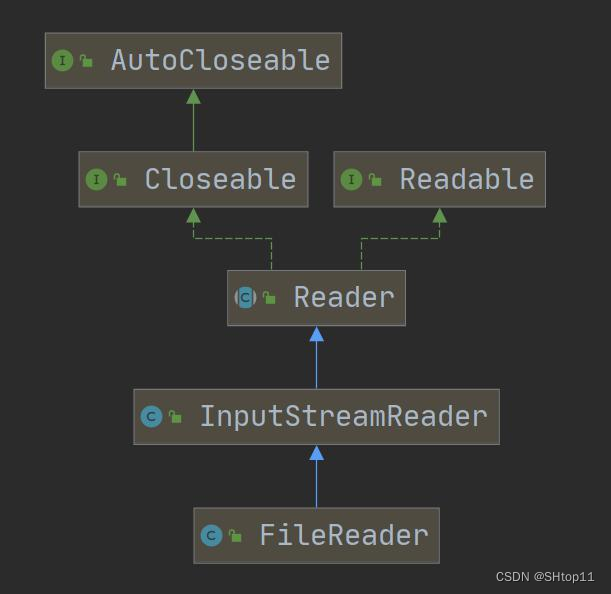

FileReader 相关方法

FileReader 应用案例
要求:使用 FileReader 从 story.txt 读取内容,并显示
public class FileReader_ {
public static void main(String[] args) {
}
/**
* 单个字符读取文件
*/
@Test
public void readFile01() {
System.out.println("~~~readFile01 ~~~");
String filePath = "d:\\story.txt";
FileReader fileReader = null;
int data = 0;
//1.创建FileReader对象
try {
fileReader = new FileReader(filePath);
//循环读取 使用read,单个字符读取
while ((data = fileReader.read()) != -1) {
System.out.print((char) data);
}
} catch (IOException e) {
e.printStackTrace();
} finally {
if (fileReader != null) {
try {
fileReader.close();
} catch (IOException e) {
e.printStackTrace();
}
}
}
}
/**
* 字符数组读取文件
*/
@Test
public void readFile02() {
System.out.println("~~~readFile02 ~~~");
String filePath = "d:\\story.txt";
FileReader fileReader = null;
int readLen = 0;
char[] buf = new char[8];
//1.创建FileReader对象
try {
fileReader = new FileReader(filePath);
//循环读取 使用 read(buf), 返回的是实际读取到的字符数
//如果返回-1, 说明到文件结束
while ((readLen = fileReader.read(buf)) != -1) {
System.out.print(new String(buf,0,readLen));
}
} catch (IOException e) {
e.printStackTrace();
} finally {
if (fileReader != null) {
try {
fileReader.close();
} catch (IOException e) {
e.printStackTrace();
}
}
}
}
}
FileWriter 常用方法

FileWriter 应用案例
要求:使用 FileWriter 将 “风雨之后,定见彩虹” 写入到 note.txt 文件中, 注意细节
public class FileWriter_ {
public static void main(String[] args) {
String filePath = "d:\\note.txt";
//创建FileWriter对象
FileWriter fileWriter = null;
char[] chars = {'a','b','c'};
try {
fileWriter = new FileWriter(filePath);//默认是覆盖写入
//write(int):写入单个字符
fileWriter.write('H');
//write(char[]):写入指定数组
fileWriter.write(chars);
//write(char[],off,len):写入指定数组的指定部分
fileWriter.write("明天吃什么".toCharArray(), 0, 3);
//write(string):写入整个字符串
fileWriter.write(" 你好西安~");
fileWriter.write("风雨之后,定见彩虹");
//write(string,off,len):写入字符串的指定部分
fileWriter.write("上海天津", 0, 2);
//在数据量大的情况下,可以使用循环操作
} catch (IOException e) {
e.printStackTrace();
} finally {
//对应 FileWriter , 一定要关闭流,或者 flush 才能真正的把数据写入到文件
//看源码就知道原因
/*
看看源码
private void writeBytes() throws IOException {
this.bb.flip();
int var1 = this.bb.limit();
int var2 = this.bb.position();
assert var2 <= var1;
int var3 = var2 <= var1 ? var1 - var2 : 0;
if (var3 > 0) {
if (this.ch != null) {
assert this.ch.write(this.bb) == var3 : var3;
} else {
this.out.write(this.bb.array(), this.bb.arrayOffset() + var2, var3);
}
}
this.bb.clear();
}
*/
try {
//fileWriter.flush();
//关闭文件流,等价 flush() + 关闭
fileWriter.close();
} catch (IOException e) {
e.printStackTrace();
}
}
System.out.println("程序结束。。");
}
}
节点流和处理流
基本介绍

节点流和处理流一览图



节点流和处理流的区别和联系

处理流的功能主要体现在以下两个方面:

处理流-BufferedReader 和 BufferedWriter


public class BufferedReader_ {
public static void main(String[] args) throws Exception {
String filePath = "d:\\story.txt";
//创建BufferedReader
BufferedReader bufferedReader = new BufferedReader(new FileReader(filePath));
//读取
String line;//按行读取,效率高
//说明
// 1.bufferedReader.readLine()是按行读取文件
// 2.当返回null 时,表示文件读取完毕
while ((line = bufferedReader.readLine()) != null) {
System.out.println(line);
}
//关闭流,这里注意,只需要关闭 BufferedReader,
//因为底层会自动的去关闭节点流 FileReader
/*
public void close() throws IOException {
synchronized (lock) {
if (in == null)
return;
try {
in.close();//in 就是我们传入的 new FileReader(filePath), 关闭了.
} finally {
in = null;
cb = null;
}
}
}
*/
bufferedReader.close();
}
}

public class BufferWriter_ {
public static void main(String[] args) throws IOException {
String filePath = "d:\\ok.txt";
//创建BufferedWriter
//说明:
// 1. new FileWriter(filePath, true) 表示以追加的方式写入
// 2. new FileWriter(filePath) , 表示以覆盖的方式写入
BufferedWriter bufferedWriter = new BufferedWriter(new FileWriter(filePath,true));
bufferedWriter.write("hello11");
bufferedWriter.newLine();//插入一个和系统相关的换行
bufferedWriter.write("hello22");
bufferedWriter.newLine();
bufferedWriter.write("hello33");
bufferedWriter.newLine();
//说明:关闭外层流即可,传入的newFileWriter(filePath),会在底层关闭
bufferedWriter.close();
}
}

public class BufferCopy_ {
public static void main(String[] args) {
//1. BufferedReader 和 BufferedWriter 是安装字符操作
//2. 不要去操作 二进制文件[声音,视频,doc, pdf ], 可能造成文件损坏
String srcFilePath = "d:\\ok.txt";
String destFilePath = "d:\\ok2.txt";
BufferedReader br = null;
BufferedWriter bw = null;
String line;
try {
br = new BufferedReader(new FileReader(srcFilePath));
bw = new BufferedWriter(new FileWriter(destFilePath));
//说明: readLine 读取一行内容,但是没有换行
while ((line = br.readLine()) != null) {
//每读取一行,就写入
bw.write(line);
//插入一个换行
bw.newLine();
}
System.out.println("拷贝完毕。。");
} catch (IOException e) {
e.printStackTrace();
}finally {
//关闭流
try {
if(br != null) {
br.close();
}
if(bw != null) {
bw.close();
}
} catch (IOException e) {
e.printStackTrace();
}
}
}
处理流-BufferedInputStream 和 BufferedOutputStream

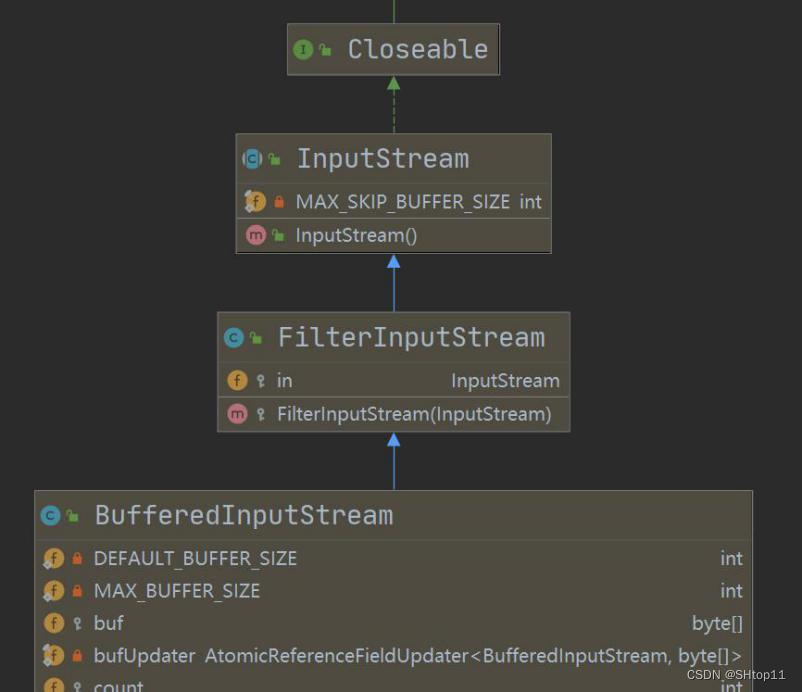
介绍 BufferedOutputStream
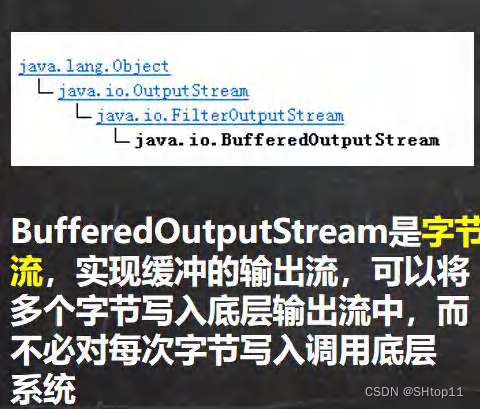


public class BufferedCopy02 {
public static void main(String[] args) {
String srcFilePath = "d:\\22.jpg";
String destFilePath = "d:\\220.jpg";
//创建 BufferedOutputStream 对象 BufferedInputStream 对象
BufferedInputStream bis = null;
BufferedOutputStream bos = null;
try {
因为 FileInputStream 是 InputStream 子类
bis = new BufferedInputStream(new FileInputStream(srcFilePath));
bos = new BufferedOutputStream(new FileOutputStream(destFilePath));
//循环的读取文件,并写入到 destFilePath
byte[] buff = new byte[1024];
int readLen = 0;
//当返回 -1 时,就表示文件读取完毕
while ((readLen = bis.read(buff)) != -1) {
bos.write(buff,0,readLen);
}
System.out.println("拷贝完毕。。");
} catch (IOException e) {
e.printStackTrace();
} finally {
//关闭流 , 关闭外层的处理流即可,底层会去关闭节点流
try {
if (bis != null) {
bis.close();
}
if (bos != null) {
bos.close();
}
} catch (IOException e) {
e.printStackTrace();
}
}
}
}
对象流-ObjectInputStream 和 ObjectOutputStream
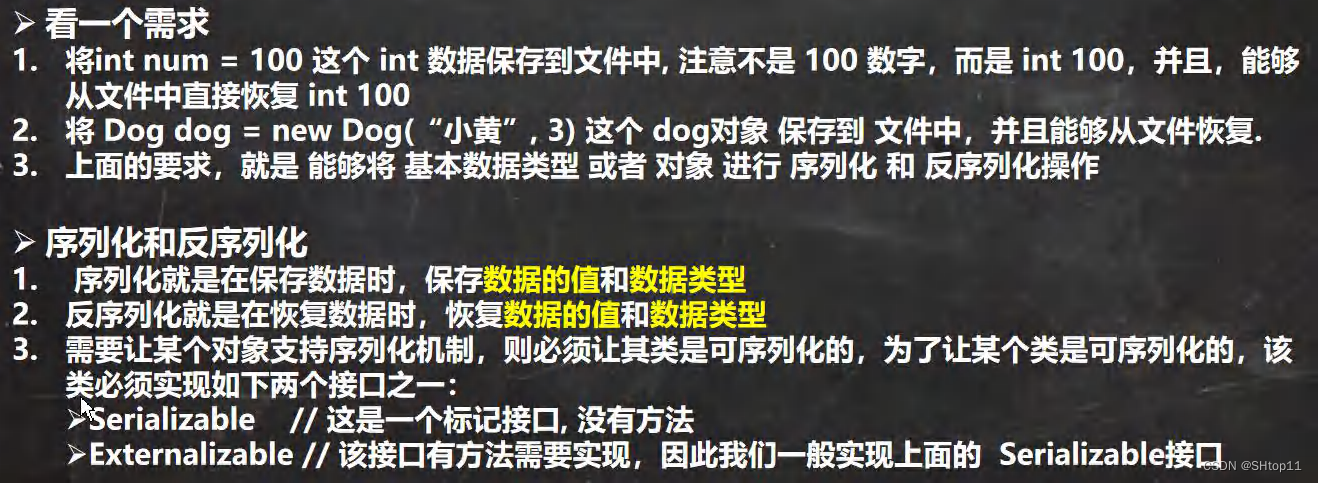
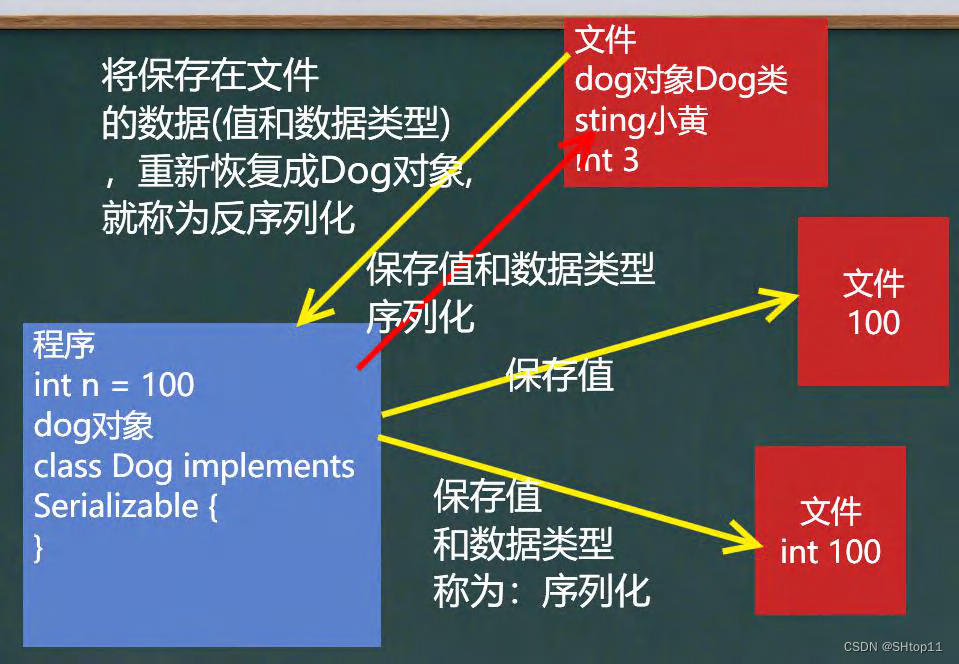
对象流介绍
功能:提供了对基本类型或对象类型的序列化和反序列化的方法
ObjectOutputStream 提供 序列化功能
ObjectInputStream 提供 反序列化功能
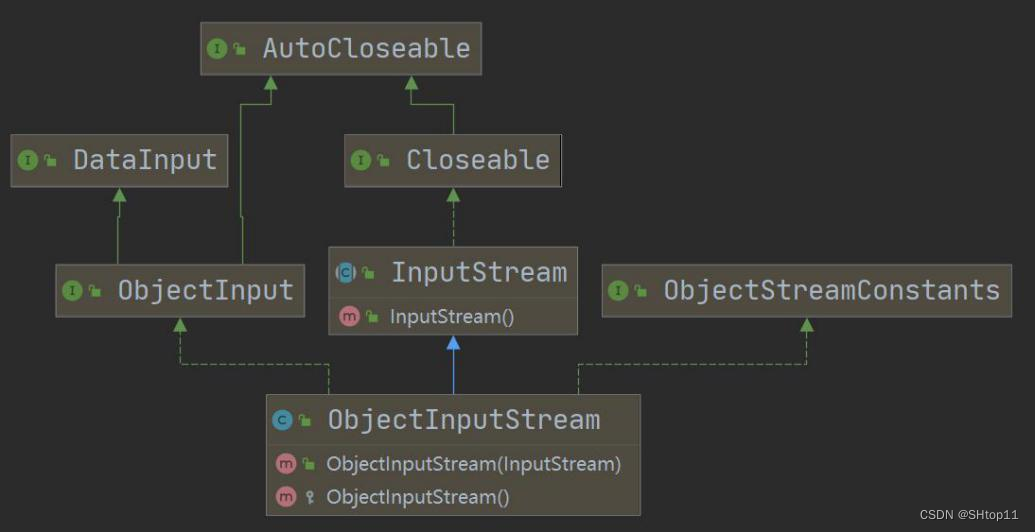
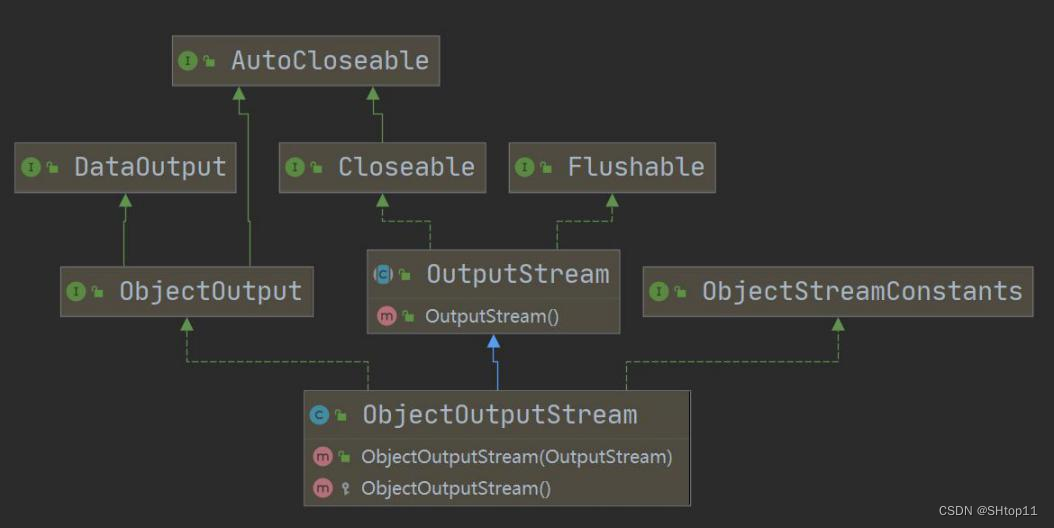
序列化

//如果需要序列化某个类的对象,实现Serializable
public class Dog implements Serializable {
private String name;
private int age;
//序列化对象时,默认将里面所有属性都进行序列化,但除了static或transient修饰的成员
private static String nation;
private transient String color;
//序列化对象时,要求里面属性的类型也需要实现序列化接口
private Master master = new Master();
//serialVersionUID序列化的版本号,可以提高兼容性
private static final long serialVersionUID = 1L;
public Dog(String name, int age, String nation, String color) {
this.name = name;
this.age = age;
this.color = color;
this.nation = nation;
}
@Override
public String toString() {
return "Dog{" +
"name='" + name + '\'' +
", age=" + age +
", color='" + color + '\'' +
'}' + " " + nation
+ " " + master;
}
public String getName() {
return name;
}
public void setName(String name) {
this.name = name;
}
public int getAge() {
return age;
}
public void setAge(int age) {
this.age = age;
}
public static String getNation() {
return nation;
}
public static void setNation(String nation) {
Dog.nation = nation;
}
public String getColor() {
return color;
}
public void setColor(String color) {
this.color = color;
}
}
public class Master implements Serializable {
}
public class ObjectOutStream_ {
public static void main(String[] args) throws IOException {
//序列化后,保存的文件格式,不是存文本,而是按照他的格式来保存
String filePath = "d:\\data.dat";
ObjectOutputStream oos = new ObjectOutputStream(new FileOutputStream(filePath));
//序列化数据到 d:\data.dat
oos.writeInt(100);// int -> Integer (实现了 Serializable)
oos.writeBoolean(true);// boolean -> Boolean (实现了 Serializable)
oos.writeChar('a');// char -> Character (实现了 Serializable)
oos.writeDouble(9.5);// double -> Double (实现了 Serializable)
oos.writeUTF("欢欢");//String
//保存一个 dog 对象
oos.writeObject(new Dog("旺财", 10,"日本", "白色"));
oos.close();
System.out.println("数据保存完毕(序列化形式)");
}
}

反序列化

public class ObjectInputStream_ {
public static void main(String[] args) throws IOException, ClassNotFoundException {
//指定反序列化的文件
String filePath = "d:\\data.dat";
ObjectInputStream ois = new ObjectInputStream(new FileInputStream(filePath));
//读取
// 1.读取(反序列化)的顺序需要和你保存数据(序列化)的顺序一致
// 2.否则会出现异常
System.out.println(ois.readInt());
System.out.println(ois.readBoolean());
System.out.println(ois.readChar());
System.out.println(ois.readDouble());
System.out.println(ois.readUTF());
//dog 的编译类型是 0bject ,dog 的运行类型是 Dog
Object dog = ois.readObject();
System.out.println("运行类型 = " + dog.getClass());
System.out.println("dog信息 = " + dog);//底层 Object -> dog
//这里是特别重要的细节:
// 1.如果我们希望调用Dog的方法,需要向下转型
// 2.需要我们将Dog类的定义,放在可以引用的位置
Dog dog2 = (Dog)dog;
System.out.println(dog2.getName());
//关闭流,关闭外层流即可,底层会关闭 FileInputStream 流
ois.close();
}
}

注意事项和细节说明

标准输入输出流

应用案例

public class InputAndOutput {
public static void main(String[] args) {
//System类的public final static Inputstream in = null;
//System.in 编译类型InputStream
//System.in 运行类型BufferedInputStream
System.out.println(System.in.getClass());
//1.System.out public final static PrintStream out = null;
//2.编译类型 PrintStream
//3.运行类型 PrintStream
//表示标准输出 显示器
System.out.println(System.out.getClass());
System.out.println("hello,欢欢~");
Scanner scanner = new Scanner(System.in);
System.out.println("输入内容:");
String next = scanner.next();
System.out.println("next=" + next);
}
}
转换流-InputStreamReader 和 OutputStreamWriter
//文件乱码问题
public class CodeQuestion {
public static void main(String[] args) throws IOException {
//读取d:\\a.txt 文件到程序
//思路
//1. 创建字符输入流 BufferedReader[处理流]
//2.使用 BufferedReader 对象读取a.txt
//3,默认情况下,读取文件是按照 utf-8 编码
String filePath = "d:\\a.txt";
BufferedReader br = new BufferedReader(new FileReader(filePath));
String s = br.readLine();
System.out.println("读取到的内容: " + s);
br.close();
}
}



public class InputStreamReader_ {
public static void main(String[] args) throws IOException {
String filePath = "d:\\a.txt";
//解读
//1.把 FileInputStream 转成 InputStreamReader
// //2.指定编码 gbk
// InputStreamReader isr = new InputStreamReader(new FileInputStream(filePath),"gbk");
// //3.把 InputStreamReader 传入 BufferedReader
// BufferedReader br = new BufferedReader(isr);
//将 2 和 3 合在一起
BufferedReader br = new BufferedReader(new InputStreamReader(new FileInputStream(filePath),"gbk"));
//4.读取
String s = br.readLine();
System.out.println("读取到的内容: " + s);
br.close();
}
}

public class OutputStreamWriter_ {
public static void main(String[] args) throws IOException {
String filePath = "d:\\sjy.txt";
String charSet = "utf-8";
OutputStreamWriter osw = new OutputStreamWriter(new FileOutputStream(filePath),charSet);
osw.write("hi,欢欢");
osw.close();
System.out.println("按照 " + charSet + " 保存文件成功~");
}
}
打印流-PrintStream 和 PrintWriter
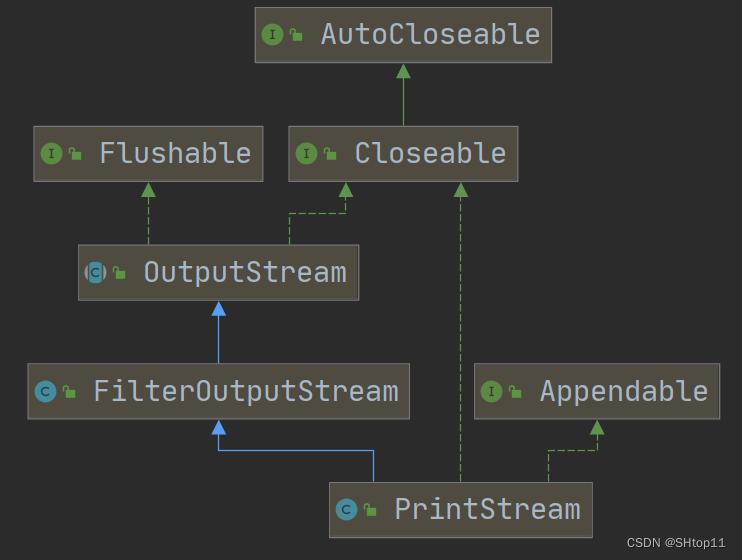
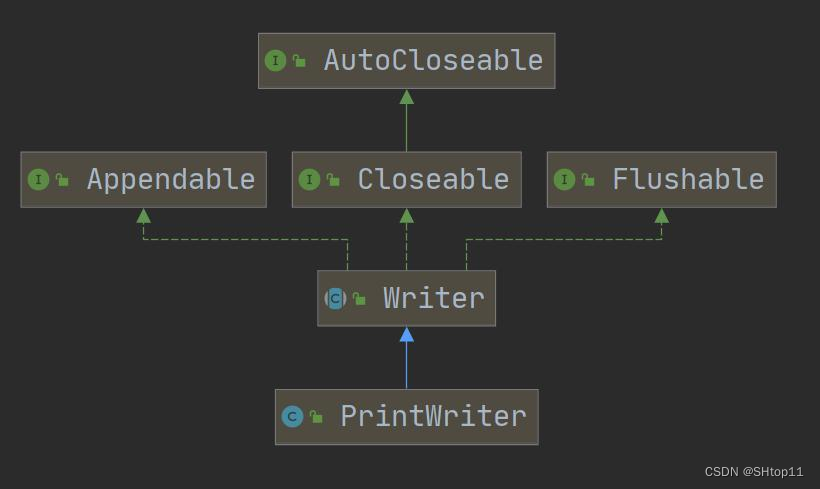
public class PrintWriter_ {
public static void main(String[] args) throws IOException {
//PrintWriter printWriter = new PrintWriter(System.out);
PrintWriter printWriter = new PrintWriter(new FileWriter("d:\\f2.txt"));
printWriter.print("hi,北京~");
printWriter.close();//flush + 关闭流, 才会将数据写入到文件..
}
}
//演示 PrintStream (字节打印流/输出流)
public class PrintStream_ {
public static void main(String[] args) throws IOException {
PrintStream out = System.out;
//在默认情况下,PrintStream 输出数据的位置是 标准输出,即显示器
out.print("john,hello");
//因为 print 底层使用的是 write , 所以我们可以直接调用 write 进行打印/输出
out.write("你好".getBytes());
/*
print 的源码
public void print(String s) {
if (s == null) {
s = "null";
}
write(s);
}
*/
out.close();
//我们可以去修改打印流输出的位置/设备
//1. 输出修改成到 "d:\\f1.txt"
//2. "hello,欢欢~" 就会输出到 d:\f1.txt
System.setOut(new PrintStream("d:\\f1.txt"));
System.out.println("hello, 欢欢~");
//3. 源码
// public static void setOut(PrintStream out) {
// checkIO();
// setOut0(out); // native 方法,修改了 out
// }
}
}
Properties 类
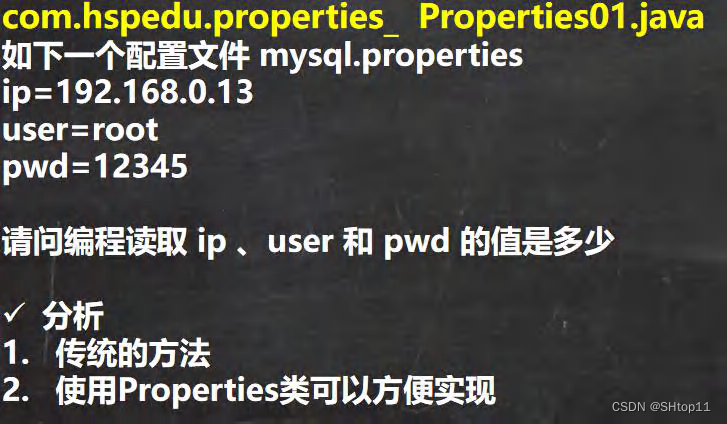
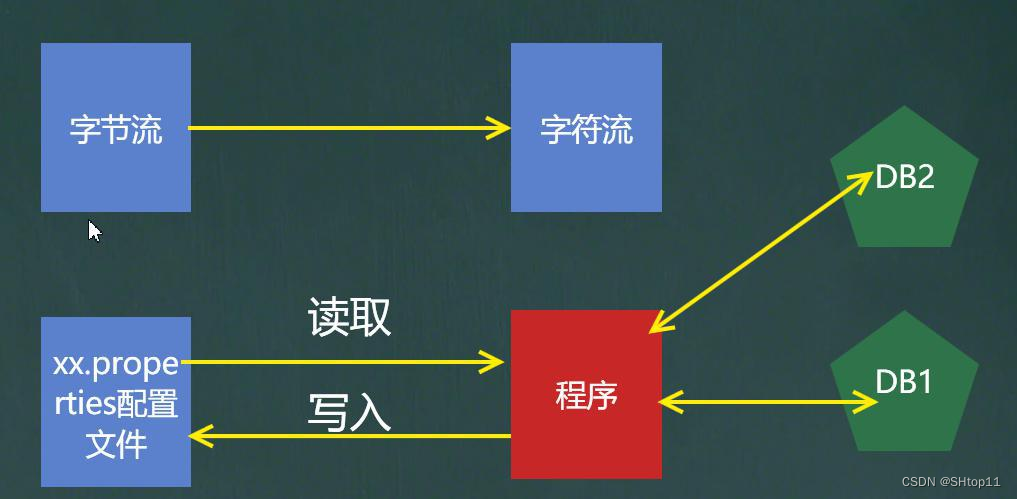
public class Properties01 {
public static void main(String[] args) throws IOException {
//读取 mysql.properties 文件,并得到 ip, user 和 pwd
BufferedReader br = new BufferedReader(new FileReader("src\\mysql.properties"));
String line = "";
while ((line = br.readLine()) != null) {
String[] split = line.split("=");
System.out.println(split[0] + " 值是: " + split[1]);
}
br.close();
}
}
基本介绍


应用案例

public class Properties02 {
public static void main(String[] args) throws IOException {
//使用 Properties 类来读取 mysql.properties 文件
//1. 创建 Properties 对象
Properties properties = new Properties();
//2. 加载指定配置文件
properties.load(new FileReader("src\\mysql.properties"));
//3. 把 k-v 显示控制台
properties.list(System.out);
//4. 根据 key 获取对应的值
String user = properties.getProperty("user");
String pwd = properties.getProperty("pwd");
System.out.println("用户名=" + user);
System.out.println("密码是=" + pwd);
}
}
public class Properties03 {
public static void main(String[] args) throws IOException {
//使用 Properties 类来创建 配置文件, 修改配置文件内容
Properties properties = new Properties();
//创建
//1.如果该文件没有 key 就是创建
//2.如果该文件有 key ,就是修改
/*
Properties 父类是 Hashtable , 底层就是 Hashtable 核心方法
public synchronized V put(K key, V value) {
// Make sure the value is not null
if (value == null) {
throw new NullPointerException();
}
// Makes sure the key is not already in the hashtable.
Entry<?,?> tab[] = table;
int hash = key.hashCode();
int index = (hash & 0x7FFFFFFF) % tab.length;
@SuppressWarnings("unchecked")
Entry<K,V> entry = (Entry<K,V>)tab[index];
for(; entry != null ; entry = entry.next) {
if ((entry.hash == hash) && entry.key.equals(key)) {
V old = entry.value;
entry.value = value;//如果 key 存在,就替换
return old;
}
}
addEntry(hash, key, value, index);//如果是新 k, 就 addEntry
return null;
}
*/
properties.setProperty("charset", "utf8");
properties.setProperty("user", "汤姆");//注意保存时,是中文的 unicode 码值
properties.setProperty("pwd", "888888");
//将 k-v 存储文件中即可
properties.store(new FileOutputStream("src\\mysql2.properties"), null);
System.out.println("保存配置文件成功~");
}
}





















 6882
6882











 被折叠的 条评论
为什么被折叠?
被折叠的 条评论
为什么被折叠?








